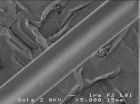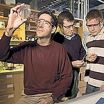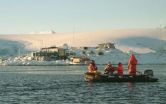(Press-News.org) A team of international researchers has provided the first comprehensive DNA evidence that the Addis Ababa lion in Ethiopia is genetically unique and is urging immediate conservation action to preserve this vulnerable lion population.
While it has long been noted that some lions in Ethiopia have a large, dark mane, extending from the head, neck and chest to the belly, as well as being smaller and more compact than other lions, it was not known until now if these lions represent a genetically distinct population.
The team of researchers, led by the University of York, UK, and the Max Planck Institute for Evolutionary Anthropology, Germany, has shown that captive lions at the Addis Ababa Zoo in Ethiopia are, in fact, genetically distinct from all lion populations for which comparative data exists, both in Africa and Asia.
The researchers compared DNA samples from 15 Addis Ababa Zoo lions (eight males and seven females) to lion breeds in the wild. The results of the study, which also involved researchers from Leipzig Zoo and the Universities of Durham and Oxford, UK, are published in the European Journal of Wildlife Research.
Principal Investigator Professor Michi Hofreiter, of the Department of Biology at the University of York, said: "To our knowledge, the males at Addis Ababa Zoo are the last existing lions to possess this distinctive mane. Both microsatellite and mitochondrial DNA data suggest the zoo lions are genetically distinct from all existing lion populations for which comparative data exist.
"We therefore believe the Addis Ababa lions should be treated as a distinct conservation management unit and are urging immediate conservation actions, including a captive breeding programme, to preserve this unique lion population."
The lion (Panthera leo) is the principal terrestrial predator in Africa and therefore a key species of the savannah ecosystem. Lion numbers are in serious decline and two significant populations of lion – the North African Barbary lions and the South African Cape lions have already become extinct in the wild.
One of the regions with a declining lion population is Ethiopia. In addition to a few hundred wild lions scattered throughout the country, 20 lions are kept in the Addis Ababa Zoo. These lions belonged to the collection of the late emperor of Ethiopia, Haile Selassie. He established the zoo in 1948 and the seven founder lions (five males and two females) are claimed to have been captured in south-western Ethiopia, although their geographical origin is controversial.
In their study, the team of researchers recommend establishing a captive breeding programme as a first step towards conserving this unique lion population.
Lead author Susann Bruche, now with Imperial College London, but who conducted the research with the Max Planck Institute for Evolutionary Anthropology, said: "A great amount of genetic diversity in lions has most likely already been lost, largely due to human influences. Every effort should be made to preserve as much of the lion's genetic heritage as possible. We hope field surveys will identify wild relatives of the unique Addis Ababa Zoo lions in the future, but conserving the captive population is a crucial first step. Our results show that these zoo lions harbour sufficient genetic diversity to warrant a captive breeding programme."
It has previously been suggested that no lions comparable to those at Addis Ababa Zoo still exist in the wild, mainly due to hunting for their mane. However, the researchers say that according to the Ethiopian authorities, lions with a similar appearance to those at Addis Ababa Zoo still exist in the east and north-east of the country, notably in the Babille Elephant Sanctuary near Harar and southwards to Hararghe. These regions, the researchers say, should be prioritised for field surveys.
Professor Hofreiter said: "A key question is which wild population did the zoo lions originate from and whether this wild population still exists; this would obviously make it a priority for conservation. What is clear is that these lions did not originate in the zoo, but come from somewhere in the wild - but not from any of the populations for which comparative data is available."
### END
Philadelphia, PA, October 11, 2012 – A paper by Shizhong Han and colleagues in the current issue of Biological Psychiatry implicates a new gene in the risk for cannabis dependence. This gene, NRG1, codes for the ErbB4 receptor, a protein implicated in synaptic development and function.
The researchers set out to investigate susceptibility genes for cannabis dependence, as research has already shown that it has a strong genetic component.
To do this, they employed a multi-stage design using genetic data from African American and European American families. In the first ...
Researchers from North Carolina State University have created flower-like structures out of germanium sulfide (GeS) – a semiconductor material – that have extremely thin petals with an enormous surface area. The GeS flower holds promise for next-generation energy storage devices and solar cells.
"Creating these GeS nanoflowers is exciting because it gives us a huge surface area in a small amount of space," says Dr. Linyou Cao, an assistant professor of materials science and engineering at NC State and co-author of a paper on the research. "This could significantly increase ...
WASHINGTON, Oct. 11—Spiders use their silk to catch lunch. Now physicists are using it to catch light. New research shows that natural silk could be an eco-friendly alternative to more traditional ways of manipulating light, such as through glass or plastic fiber optic cables. Two teams independently exploring possible applications for the material's photonic talents will present their latest breakthroughs at the Optical Society's (OSA) Annual Meeting, Frontiers in Optics (FiO) 2012, to be held next week in Rochester, N.Y.
Biomedical engineer Fiorenzo Omenetto of Tufts ...
Hospital superbugs can float on air currents and contaminate surfaces far from infected patients' beds, according to University of Leeds researchers.
The results of the study, which was funded by the Engineering and Physical Sciences Research Council (EPSRC), may explain why, despite strict cleaning regimes and hygiene controls, some hospitals still struggle to prevent bacteria moving from patient to patient.
It is already recognised that hospital superbugs, such as MRSA and C-difficile, can be spread through contact. Patients, visitors or even hospital staff can inadvertently ...
EAST LANSING, Mich. — Contrary to past research, private school students in India do not outperform their counterparts in public schools, finds a new study by a Michigan State University education researcher.
The study challenges the claim that private schools are superior – a hot issue in India and other developing countries that are expanding K-12 educational offerings. During the past decade, some 40 million children have entered India's education system, giving rise to a growth in privately run schools.
"Our study finds no consistent benefit of attending a private ...
AMHERST, Mass. – Until recently, medical researchers had little hope of experimentally manipulating naïve T cells to study their crucial roles in immune function, because they were largely impenetrable, says polymer scientist Gregory Tew: "So far off limits we could not readily get inside to investigate their workings."
Now, he and colleagues including immunologist Lisa Minter have found a way not only to get inside naïve T cells, but to deliver bio-active cargo such as proteins and synthetic molecules across that long-locked cell membrane, by using a new synthetic protein ...
WASHINGTON and NEW YORK – A new report finds that Texas policies to exclude Planned Parenthood clinics from a state family planning program – the Women's Health Program (WHP) – would result in leaving tens of thousands of women unable to get care.
"Deteriorating Access to Women's Health Services in Texas: Potential Effects of the Women's Health Program Affiliate Rule," released by the Geiger Gibson/RCHN Community Health Foundation Research Collaborative in the Department of Health Policy of the George Washington University School of Public Health and Health Services, ...
Scientists have proved a 60-year-old theory about how nerve signals are sent around the body at varying speeds as electrical impulses.
Researchers tested how these signals are transmitted through nerve fibres, which enables us to move and recognise sensations such as touch and smell.
The findings from the University of Edinburgh have validated an idea first proposed by Nobel laureate Sir Andrew Huxley.
It has been known for many years that an insulating layer – known as myelin – which surrounds nerve fibres is crucial in determining how quickly these signals are ...
Differing contributions of freshwater from glaciers and streams to the Arctic and Southern oceans appear to be responsible for the fact that the majority of microbial communities that thrive near the surface at the Poles share few common members, according to an international team of researchers, some of whom were supported by the National Science Foundation (NSF).
In a paper published in the Oct. 8 edition of the Proceedings of the National Academy of Sciences (PNAS), the researchers report that only 25 percent of the taxonomic groups identified by genetic sequencing ...
Domestic violence rates rose by an average of 30 percent each time England won or lost their games during the 2010 World Cup, but draws had little impact on the statistics.
Those are the key findings of research carried out by statistician Professor Allan Brimicombe and BBC News journalist Rebecca Cafe and published in the October issue of Significance, the magazine of The Royal Statistical Society and the American Statistical Association.
As a consequence of this and previous research, Professor Brimicombe believes there is a strong case for schools to educate pupils ...




